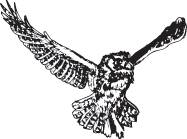

Owl facts
Three very important things to remember about owls are:
- Owls have fuzz on the tops and back edges of their wing and tail feathers that allows them to fly silently. This helps them ambush their prey.
- Owls have excellent hearing that is 4 or 5 times better than a human. Owls can hear a mouse running in the grass 100 yards away. That's the length of a football field!
- Owls have very sharp talons on four powerful toes. They usually stand with two toes forward and two toes backward.
Other important things to remember about owls are:
- Owl's eyes are in the front of their heads. This allows them to have excellent depth perception. Owl's eyes are so large that they can not move in their sockets. Seven extra bones in their necks allow them to turn their heads 270 degrees. Owls have black and white vision.
- Owls, like all birds, have very good eyesight. They can see eight times better than humans.
- Owl's eyes fill most of their skulls, leaving little space for their brains. Most of their very small brain is involved wiht their excellent hearing and eyesight.
- Owls have a facial disk of feathers that sends light to their eyes and sound to their ears.
- Owls fly slowly, 20 to 30 miles per hour. They are able to lift straight off the ground or to hover (stop in flight).
- Most owls are nocturnal (they are active at night). Some owls are crepuscular (they are active early in the morning during dawn and late in the day at dusk).
- Most owls are opportunistic feeders and they will eat what ever they can catch. They will eat insects, toads, frogs, snakes, mice, voles, rats, shrews, chipmunks and even other birds.
- Owls catch and kill their prey with their powerful feather-covered feet. Owls have very large mouths that allow them to swallow most of their food whole.
- Owls can fly carrying prey four times their weight. Large prey that they cannot swallow whole is carried up into a tree where it can be eaten, safe from other predators.
- The next day after eating owls cough up a pellet that contains the fur, feathers and bones of all the animals they ate the night before. Owls do not have strong stomach juices so only the smaller bones are digested.
- Owls do not build nests! They usually will take an old hawk's or squirrel's nest and use it. Owl nests are usually full of pellets, scraps of food and droppings.
- Tufted owls such as the Screech Owl use their feather tufts to "talk" to neighboring owls. They can also camouflage themselves by using their feather tufts to help them look like a broken branch.
- There are eight different kinds -- species -- of owls that live and nest in New York State.
- Fossil owls have been found that were 50 million years old. Owls must have developed shortly after the dinosaurs became extinct at the end of the Cretaceous Period.